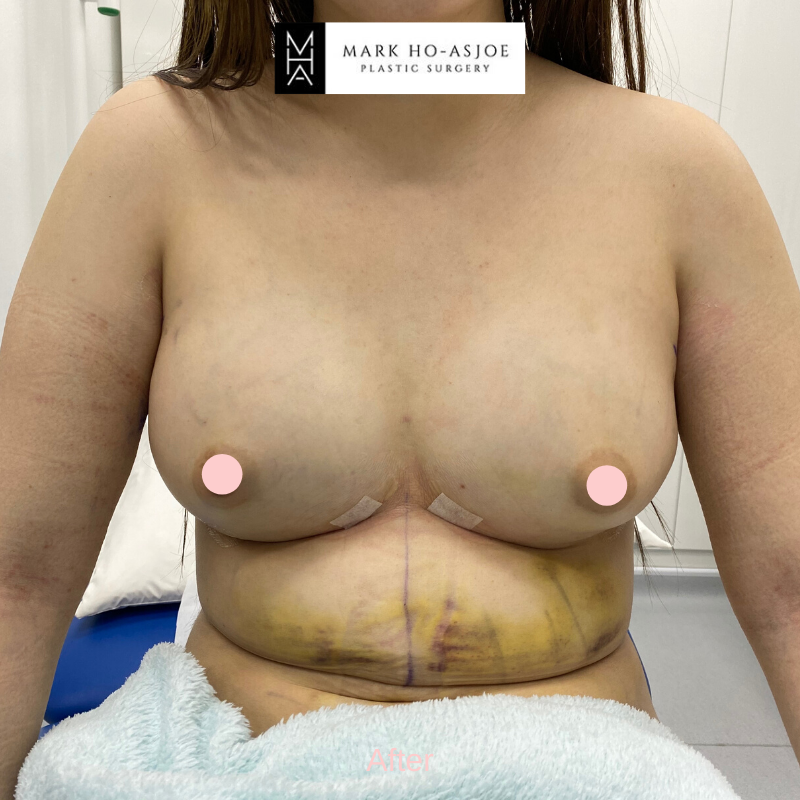WHAT IS INVOLVED IN A BREAST AUGMENTATION (FAT TRANSFER)?
Autologous (patients’ own) fat transfer or lipo-modeling is an alternative choice for breast augmentation and body contouring. In this technique, fat cells can be removed surgically using the liposuction technique. After infiltration of local anaesthetic and saline solution, the patient’s fat cells are removed. This is done using a cannula through small stab incisions around a few millimeters in size. The fat cells are usually discarded in liposuction. However, when it comes to breast augmentation and body contouring using fat transfer, the fat can be injected into another part of the body. The two most common areas for volume augmentation using fat transfer are the breast and facial region. Due to the risk of complications, fat transfer to the buttock region has been halted in UK.
Fat injections into breasts have been around over the last 20 years. With improvements in technique, it has continued to gain popularity in recent years. It is most commonly used for contour defects and shape transformation in patients who have had breast reconstruction. The use of fat transfer has also been noted to improve skin and tissue quality after previous radiotherapy. With the current issues related to breast implants, the use of fat transfer in breast augmentation is gaining popularity and some patients are interested in exploring alternative options.
WHAT ARE THE ADVANTAGES?
There are a number of advantages associated with fat transfer or lipo-modeling breast augmentation compared with implant augmentation. Unlike implant augmentation, where an incision has to be made, fat transfer involves fat being injected through 1-2mm holes using syringes/cannulae. This leaves scars that are inconspicuous once settled. After the swelling has reduced and the injected fat is revascularized, the result of the augmentation is permanent. The fat in the breast now behaves like other fatty tissue and can change with weight, hormones and age. This means no further surgery is required except if the patient requires further volume augmentation.
This is in contrast to implant augmentation where the implant is likely to require an exchange at some point in the future. One thing to bear in mind is that with the fat transfer technique, patients will need to have an excess of fatty tissue that can be harvested. This can be from their abdomen, thigh and back and therefore, may not suit all patients.
WHAT ARE THE OTHER OPTIONS?
The more common technique of implant augmentation is still more popular than fat transfer or lipo-modeling. Implant augmentation uses either a silicone- or saline-filled implant that is inserted into the breast pocket through a small incision. Since the implant is manufactured, liposuction is not needed. Thus, the post-operative discomfort is less and only limited to the breast region. Since the volume of the implant is limited, it simply means a bigger volume increment can be attained in a single operation in comparison to fat transfer.
However, large implant augmentation can produce a very unnatural appearance with excess lateral projection, excessive upper pole fullness and animation in those patients with submuscular implant placement. Stretching of the breast tissue and skin can lead to skin rippling and striae (stretch marks). It is important to realize implants are not permanent and will need to be exchanged at some point in time. There are issues that need to be clarified before proceeding with implant augmentation and your surgeon will explain those to you.
WHAT IS A HYBRID AUGMENTATION?
Breast augmentation using fat transfer and implants are not mutually exclusive and could be carried out in conjunction with each other. This is known as Hybrid augmentation. This is where the implant provides a certain degree of volume augmentation. Then fat transfer can then be used to increase the soft tissue coverage of the implant. In some cases, the fat can also be used to increase medial or upper pole fullness. The volume produced by fat transfer can also mean a smaller implant being employed and help to increase the overall natural appearance of the breast.
Of course, the choice of technique to achieve volume augmentation using fat or implants is a personal one. It is important to have a thorough consultation with your Plastic Surgeon. This allows you to discuss your wishes and any concerns you may have and help you to make the right decision.
You can view full surgical VIDEOS on this procedure on Mr Mark Ho-Asjoe's YouTube Channel or why not read his latest blog - Breast Augmentation procedure with Fat Transfer




